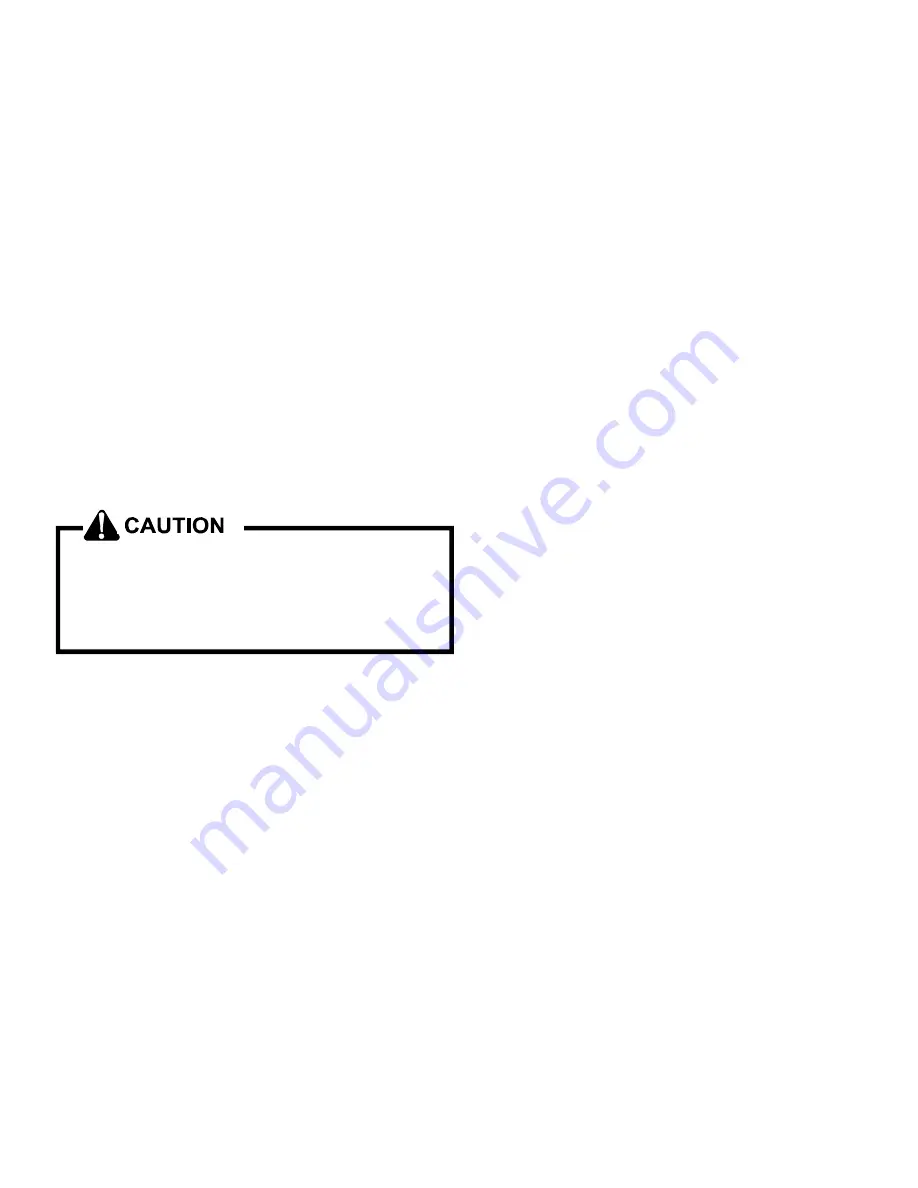
24
SCHEDULED MAINTENANCE
Example:
It takes forty (40) seconds on the gas meter for the hand on the
cubic foot dial to make one complete revolution, with all appli-
ances off, except the unit. Using the gas rate chart, observe
the forty (40) seconds, locate and read across to the one (1)
cubic foot dial column. There you will find the number 90,
which shows that ninety (90) cubic feet of gas will be con-
sumed in one (1) hour.
Let's assume the local gas utility has stated that the calorific
value of the gas is 1025 BTU per cubic foot.
Multiplying the ninety (90) cubic feet by 1025 BTU/ft
3
gives us
an input of 92,250 BTU/hr.
Checking the BTU input on the rating plate of the unit being
tested.
EXAMPLE:
APG10300901A
INPUT:
92,000 BTU/HR
OUTPUT CAP:
72,900 BTU/HR
Should the figure you calculated not fall within five (5) percent
of the nameplate rating of the unit, adjust the gas valve pres-
sure regulator or resize orifices.
In no case should the input
exceed that shown on the rating plate.
Always connect a manometer to the 1/8” pipe tap at
the gas valve before adjusting the pressure regulator.
In no case should the final manifold pressure vary
more than plus or minus .3 inches water column
from 3.5 inches water column for natural gas or 10
inches water column for propane gas.
To adjust the pressure regulator on the gas valve, turn down
(clockwise) to increase pressure and input, and out (counter-
clockwise) to decrease pressure and input.
Since propane gas is not normally installed with a gas meter,
clocking will be virtually impossible. The gas orifices used
with propane are calculated for 2500 BTU gas per cubic foot
and with proper inlet pressures and correct piping size, full
capacity will be obtained.
With propane gas, no unit gas valve regulator is used; how-
ever, the second stage supply line pressure regulator should
be adjusted to give 11" water column with all other gas con-
suming appliances running.
The dissipation of the heat transferred to the heat exchanger is
now controlled by the amount of air circulated over its surface.
The flow rate (CFM) of air circulated is governed by the exter-
nal static pressure in inches of water column of duct work,
cooling coil, registers and etc., applied externally to the unit
versus the motor speed tap.
A properly operating unit must have the BTU input and flow
rate (CFM) of air, within the limits shown to prevent short cy-
cling of the equipment. As the external static pressure goes
up, the temperature rise will also increase. Consult the proper
tables for temperature rise limitation.

![Preview for 10 page of Goodman [A/G]PG Service Instructions Manual](http://thumbs.mh-extra.com/thumbs/goodman/a-g-pg/a-g-pg_service-instructions-manual_2243406-10.webp)
![Preview for 11 page of Goodman [A/G]PG Service Instructions Manual](http://thumbs.mh-extra.com/thumbs/goodman/a-g-pg/a-g-pg_service-instructions-manual_2243406-11.webp)
![Preview for 12 page of Goodman [A/G]PG Service Instructions Manual](http://thumbs.mh-extra.com/thumbs/goodman/a-g-pg/a-g-pg_service-instructions-manual_2243406-12.webp)
![Preview for 13 page of Goodman [A/G]PG Service Instructions Manual](http://thumbs.mh-extra.com/thumbs/goodman/a-g-pg/a-g-pg_service-instructions-manual_2243406-13.webp)
![Preview for 14 page of Goodman [A/G]PG Service Instructions Manual](http://thumbs.mh-extra.com/thumbs/goodman/a-g-pg/a-g-pg_service-instructions-manual_2243406-14.webp)
![Preview for 15 page of Goodman [A/G]PG Service Instructions Manual](http://thumbs.mh-extra.com/thumbs/goodman/a-g-pg/a-g-pg_service-instructions-manual_2243406-15.webp)
![Preview for 16 page of Goodman [A/G]PG Service Instructions Manual](http://thumbs.mh-extra.com/thumbs/goodman/a-g-pg/a-g-pg_service-instructions-manual_2243406-16.webp)
![Preview for 17 page of Goodman [A/G]PG Service Instructions Manual](http://thumbs.mh-extra.com/thumbs/goodman/a-g-pg/a-g-pg_service-instructions-manual_2243406-17.webp)
![Preview for 18 page of Goodman [A/G]PG Service Instructions Manual](http://thumbs.mh-extra.com/thumbs/goodman/a-g-pg/a-g-pg_service-instructions-manual_2243406-18.webp)
![Preview for 19 page of Goodman [A/G]PG Service Instructions Manual](http://thumbs.mh-extra.com/thumbs/goodman/a-g-pg/a-g-pg_service-instructions-manual_2243406-19.webp)
![Preview for 20 page of Goodman [A/G]PG Service Instructions Manual](http://thumbs.mh-extra.com/thumbs/goodman/a-g-pg/a-g-pg_service-instructions-manual_2243406-20.webp)
![Preview for 21 page of Goodman [A/G]PG Service Instructions Manual](http://thumbs.mh-extra.com/thumbs/goodman/a-g-pg/a-g-pg_service-instructions-manual_2243406-21.webp)
![Preview for 22 page of Goodman [A/G]PG Service Instructions Manual](http://thumbs.mh-extra.com/thumbs/goodman/a-g-pg/a-g-pg_service-instructions-manual_2243406-22.webp)
![Preview for 23 page of Goodman [A/G]PG Service Instructions Manual](http://thumbs.mh-extra.com/thumbs/goodman/a-g-pg/a-g-pg_service-instructions-manual_2243406-23.webp)
![Preview for 24 page of Goodman [A/G]PG Service Instructions Manual](http://thumbs.mh-extra.com/thumbs/goodman/a-g-pg/a-g-pg_service-instructions-manual_2243406-24.webp)
![Preview for 25 page of Goodman [A/G]PG Service Instructions Manual](http://thumbs.mh-extra.com/thumbs/goodman/a-g-pg/a-g-pg_service-instructions-manual_2243406-25.webp)
![Preview for 26 page of Goodman [A/G]PG Service Instructions Manual](http://thumbs.mh-extra.com/thumbs/goodman/a-g-pg/a-g-pg_service-instructions-manual_2243406-26.webp)
![Preview for 27 page of Goodman [A/G]PG Service Instructions Manual](http://thumbs.mh-extra.com/thumbs/goodman/a-g-pg/a-g-pg_service-instructions-manual_2243406-27.webp)
![Preview for 28 page of Goodman [A/G]PG Service Instructions Manual](http://thumbs.mh-extra.com/thumbs/goodman/a-g-pg/a-g-pg_service-instructions-manual_2243406-28.webp)
![Preview for 29 page of Goodman [A/G]PG Service Instructions Manual](http://thumbs.mh-extra.com/thumbs/goodman/a-g-pg/a-g-pg_service-instructions-manual_2243406-29.webp)
![Preview for 30 page of Goodman [A/G]PG Service Instructions Manual](http://thumbs.mh-extra.com/thumbs/goodman/a-g-pg/a-g-pg_service-instructions-manual_2243406-30.webp)
![Preview for 31 page of Goodman [A/G]PG Service Instructions Manual](http://thumbs.mh-extra.com/thumbs/goodman/a-g-pg/a-g-pg_service-instructions-manual_2243406-31.webp)
![Preview for 32 page of Goodman [A/G]PG Service Instructions Manual](http://thumbs.mh-extra.com/thumbs/goodman/a-g-pg/a-g-pg_service-instructions-manual_2243406-32.webp)
![Preview for 33 page of Goodman [A/G]PG Service Instructions Manual](http://thumbs.mh-extra.com/thumbs/goodman/a-g-pg/a-g-pg_service-instructions-manual_2243406-33.webp)
![Preview for 34 page of Goodman [A/G]PG Service Instructions Manual](http://thumbs.mh-extra.com/thumbs/goodman/a-g-pg/a-g-pg_service-instructions-manual_2243406-34.webp)
![Preview for 35 page of Goodman [A/G]PG Service Instructions Manual](http://thumbs.mh-extra.com/thumbs/goodman/a-g-pg/a-g-pg_service-instructions-manual_2243406-35.webp)
![Preview for 36 page of Goodman [A/G]PG Service Instructions Manual](http://thumbs.mh-extra.com/thumbs/goodman/a-g-pg/a-g-pg_service-instructions-manual_2243406-36.webp)
![Preview for 37 page of Goodman [A/G]PG Service Instructions Manual](http://thumbs.mh-extra.com/thumbs/goodman/a-g-pg/a-g-pg_service-instructions-manual_2243406-37.webp)
![Preview for 38 page of Goodman [A/G]PG Service Instructions Manual](http://thumbs.mh-extra.com/thumbs/goodman/a-g-pg/a-g-pg_service-instructions-manual_2243406-38.webp)
![Preview for 39 page of Goodman [A/G]PG Service Instructions Manual](http://thumbs.mh-extra.com/thumbs/goodman/a-g-pg/a-g-pg_service-instructions-manual_2243406-39.webp)











